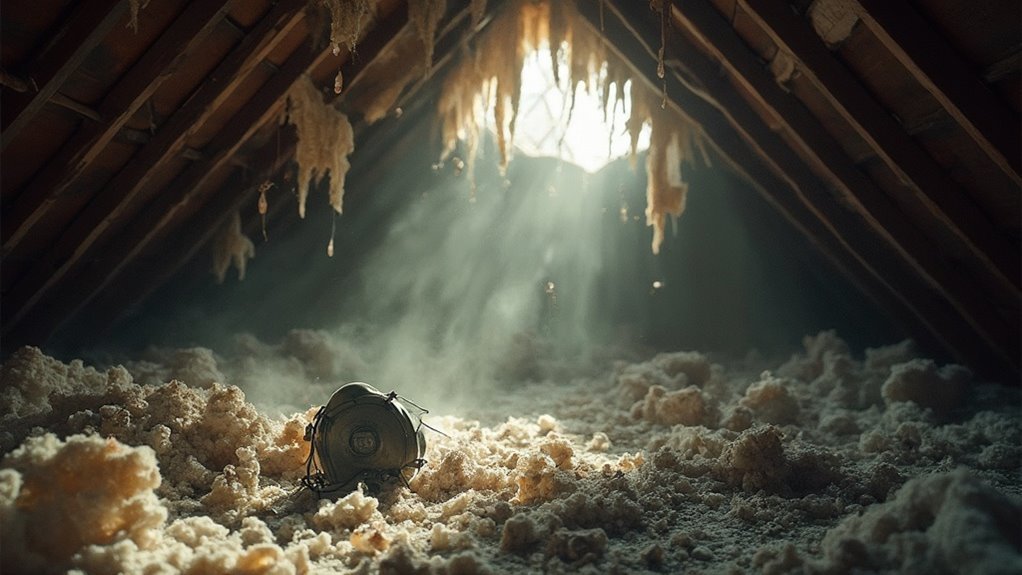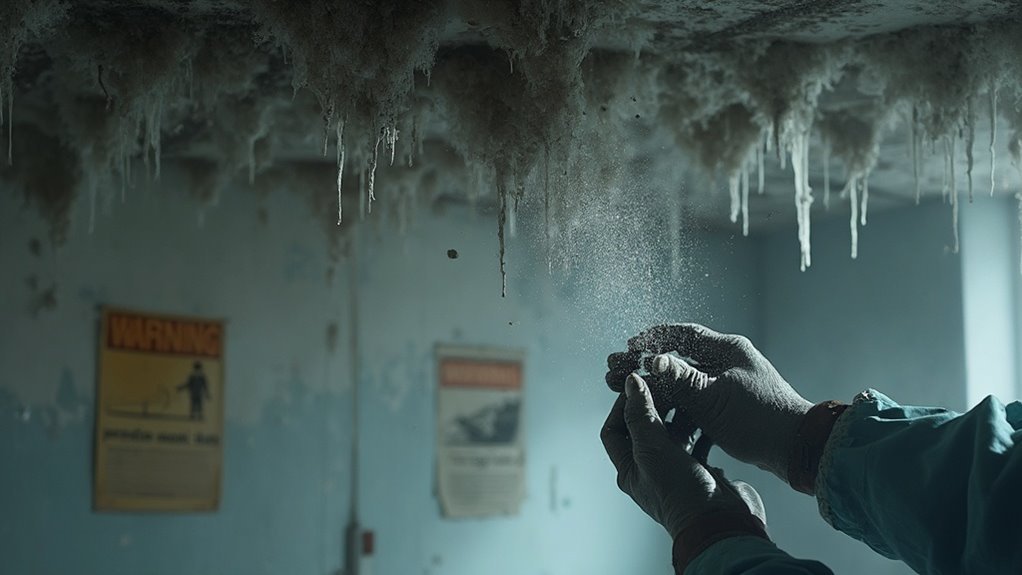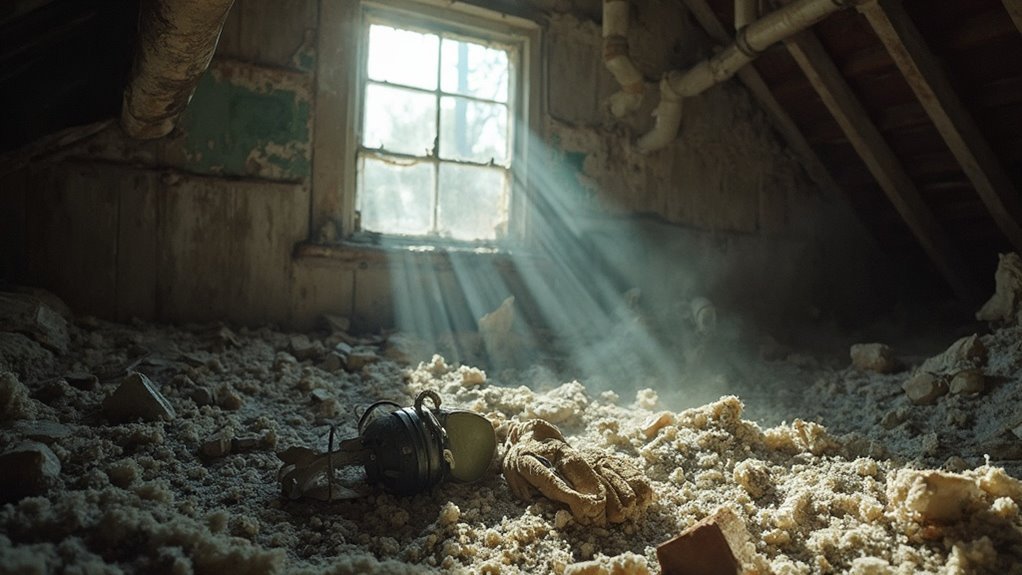Asbestos poses severe health risks, including lung cancer and mesothelioma, which can emerge decades after exposure. Older homes commonly contain asbestos in various materials, making DIY renovations particularly hazardous. If these fibers are disturbed, they can become airborne, leading to respiratory diseases. Professional removal is essential as it guarantees safe handling under strict regulations, minimizing the risk of exposure for you and others. Trained experts conduct thorough inspections and take necessary precautions to contain and dispose of asbestos properly. Understanding the depth of these dangers and the importance of professional assistance can lead you to critical information on safety measures.
Health Risks of Asbestos Exposure

Understanding the health risks of asbestos exposure is important for anyone who may come into contact with this hazardous material. Asbestos exposure can lead to serious health issues, including asbestosis, lung cancer, and mesothelioma. Asbestosis causes lung scarring and can result in breathing difficulties, while lung cancer risk increases considerably, especially for smokers. Mesothelioma, a rare but aggressive cancer, primarily affects the lining of the lungs and abdomen, resulting from asbestos inhalation.
It's important to recognize common asbestos symptoms, such as persistent cough, chest pain, and shortness of breath, which may not appear until years after exposure. The development of these diseases often takes 15 to 50 years, making early detection critical. Increased risk of lung cancer and mesothelioma among asbestos workers underscores the need for awareness and preventative measures. Additionally, approximately 255,000 deaths annually are linked to asbestos-related diseases, highlighting the urgency of addressing this issue.
To mitigate these risks, exposure prevention is fundamental. Safe removal of asbestos by professionals is key to prevent fiber release, and using personal protective equipment (PPE) during handling can further reduce risk. Awareness and training about the dangers of asbestos, along with regular health monitoring, can greatly help in identifying potential issues early on. By understanding these health risks, you can take proactive measures to protect yourself and others from asbestos-related diseases.
Hidden Dangers in Homes
When you live in an older home, you might unknowingly encounter hidden dangers like asbestos lurking in insulation, flooring, or textured ceilings. If you're considering renovations, be cautious; disturbing these materials can release harmful fibers into the air. Understanding the risks associated with asbestos is vital for maintaining a safe living environment. Proactive asbestos inspections can help identify these dangers before they become a serious health risk.
Asbestos in Older Homes
As you investigate older homes, it's important to keep an eye out for hidden dangers, particularly asbestos. This material was widely used before the 1980s for its heat and corrosion resistance, making it common in various building products like insulation, floor tiles, and roofing shingles. While not every older home contains asbestos, it's important to assume its presence until a professional home inspection confirms otherwise.
Asbestos can be particularly hazardous in materials that are crumbling or disturbed, releasing dangerous fibers into the air. Homes built between 1930 and 1950 often have asbestos-containing materials, including in attics where vermiculite insulation might be present. Consequently, you should prioritize asbestos testing if you suspect its existence in your home.
Inhaling asbestos fibers can lead to serious health issues, including lung cancer and other respiratory diseases, with symptoms often surfacing decades later. Given these risks, never attempt to handle or remove suspected asbestos materials yourself. Instead, seek professional assistance for thorough inspections and safe remediation, ensuring your living environment is secure for you and your family.
Risks During Renovations
Renovating older homes can reveal hidden dangers, particularly the risk of asbestos exposure. If you're working on a structure built before the 1980s, you may encounter asbestos-containing materials (ACMs) in insulation, flooring, roofing, or siding. These materials can release microscopic asbestos fibers into the air when disturbed, posing serious health risks. Unfortunately, DIY renovators are often unaware of these dangers; a study found that 60.5% reported exposure during renovations.
To guarantee renovation safety, it's vital to adhere to asbestos regulations and seek professional help. Trained contractors can identify ACMs and safely remove them, greatly reducing the risk of exposure. They follow strict protocols, such as sealing off work areas and using protective gear, to prevent fiber release. Even minor disturbances can lead to harmful inhalation of asbestos fibers, which may result in long-term health issues like mesothelioma and lung cancer.
Always assume that older materials may contain asbestos unless proven otherwise. If you're unsure about the presence of asbestos, getting a professional assessment is imperative before proceeding with renovations. Prioritize safety and protect your health by enlisting expert assistance.
Disturbing Asbestos Materials
Disturbing asbestos materials in your home can expose you to significant health risks, especially if you're unaware of where these hazardous materials might be lurking. Asbestos can be found in various locations, and disturbing these materials can release harmful fibers into the air. It's vital to identify areas that may contain asbestos before starting any renovation or repair work.
Here are some common hidden dangers in homes:
- Insulation: Vermiculite, pipe insulation, and duct insulation often contain asbestos.
- Flooring: Vinyl asbestos tiles, older linoleum, and adhesive mastic may pose risks.
- Ceilings: Popcorn ceilings and ceiling tiles might likewise harbor asbestos.
For effective asbestos detection, consider hiring a professional to assess your home. If you suspect the presence of asbestos, do not attempt to remove it yourself; the fibers can become airborne and lead to serious health issues. Safe disposal of asbestos materials is paramount, and professionals have the training and equipment to handle it properly. Prioritize your health by addressing potential asbestos hazards with caution and expertise.
Global Impact of Asbestos

As you investigate the global impact of asbestos, it's essential to recognize the staggering health statistics that reveal its deadly consequences. With over 200,000 annual deaths linked to occupational exposure, the urgency for legislative action becomes clear. Many countries have taken steps to ban asbestos, yet the challenge remains significant in regions still grappling with its use and associated health risks.
Global Health Statistics
Globally, asbestos exposure poses a significant health risk, affecting approximately 125 million individuals in workplaces and leading to an alarming 107,000 deaths each year as a consequence of occupational exposure. These asbestos statistics underscore the urgent need for awareness and action regarding global exposure to this hazardous material.
Consider these striking facts:
- Asbestos causes an estimated 255,000 deaths annually, with work-related exposures accounting for 233,000 of those fatalities.
- Mesothelioma, one of the world's leading occupational cancers, is projected to see rising rates because of asbestos's long latency period.
- There are over 4 million disability-adjusted life years lost directly related to asbestos exposure.
The ongoing use and production of asbestos in various countries intensify these issues, putting countless people at risk. The economic burden associated with these health risks is staggering, emphasizing the importance of professional removal and stringent regulations. Without decisive action, the consequences of asbestos exposure will continue to affect lives, communities, and economies worldwide. Understanding these global health statistics is crucial for promoting a safer, asbestos-free future.
Legislative Actions Worldwide
How do legislative actions shape the global response to asbestos exposure? By establishing robust asbestos regulations, countries align with international policies that emphasize safety and health standards. The International Labour Organisation (ILO) and the World Health Organisation (WHO) have led the charge, advocating for thorough bans and protective measures against asbestos. Their guidelines influence national policies, pushing for stricter controls and the eventual phasing out of this hazardous material.
For example, the European Union mandates strict exposure controls, while North America has varying regulations, with Canada implementing a thorough ban in 2018. In Asia, Japan has adopted stringent regulations, yet enforcement remains problematic in countries like China and India. Australia and New Zealand have likewise enacted total bans, demonstrating a commitment to public safety.
Nonetheless, challenges persist, especially in developing nations where enforcement is weak. In spite of bans in over 50 countries, an estimated 2 million tons of asbestos are still used annually. The need for global cooperation is clear; promoting public health campaigns and conditional aid tied to asbestos bans could encourage compliance and ultimately protect lives.
Challenges in Prevention
Preventing asbestos exposure poses significant challenges that stem from various factors, including geographic risks, building hazards, and public awareness deficits. You might not realize it, but your environment plays an essential role in your exposure risk. For instance, living near natural asbestos deposits puts you at greater risk, especially if unpaved roads stir up dust.
To effectively tackle these challenges, consider the following prevention strategies and community initiatives:
- Increase public awareness: Educate your community about the dangers of asbestos and how to identify potential hazards.
- Advocate for stronger regulations: Push for clearer policies that guarantee safe handling and removal of asbestos in buildings and natural sites.
- Promote worker safety: Support programs that provide training and protective equipment for workers in high-risk occupations.
Importance of Professional Removal

When it comes to addressing asbestos hazards in your home or workplace, the significance of professional removal cannot be overstated. Asbestos is a hazardous material requiring specialized knowledge and expertise, which is why relying on trained professionals is essential. Technicians undergo extensive professional training to handle asbestos safely, guaranteeing compliance with strict safety protocols that protect both workers and occupants.
Professional removal involves a complex process, including sealing the work area to prevent fiber spread and using specialized equipment like HEPA filter vacuums. Experts conduct thorough inspections to identify all asbestos-containing areas, minimizing the risk of overlooked hazards. Their adherence to local and national regulations assures that the removal and disposal processes are legally compliant, avoiding potential fines or liabilities.
Furthermore, professionals implement effective decontamination procedures and employ personal protective equipment to safeguard against exposure. By choosing a service with proven experience and proper credentials, you guarantee a complete cleanup and safe disposal of asbestos materials. This not only protects your health but additionally provides peace of mind, knowing that your environment is secure from the dangers of asbestos.
Long-Term Consequences of Exposure
Long-term exposure to asbestos can have devastating health consequences, with multiple serious diseases stemming from inhalation of its fibers. You might not notice asbestos symptoms immediately, as these conditions often develop over a lengthy exposure timeline—typically 20 to 50 years after initial contact.
The most concerning diseases associated with asbestos include:
- Asbestosis: A chronic lung condition leading to significant breathing difficulties.
- Lung Cancer: Resulting from prolonged irritation of lung tissues by asbestos fibers.
- Mesothelioma: A rare and aggressive cancer affecting the lining of internal organs.
These diseases can manifest well after the exposure period, complicating diagnosis and treatment. Furthermore, if you're a smoker, your risk of developing lung cancer sharply increases when combined with asbestos exposure. Even non-cancerous conditions, like pleural thickening and pleural plaques, can arise, causing discomfort and respiratory issues.
Given the serious and often fatal nature of these diseases, understanding the long-term consequences of asbestos exposure is essential. Awareness of potential health risks can encourage proactive measures to limit exposure and seek professional removal if necessary.
Safe Handling Practices

Safe handling practices are vital when dealing with asbestos to minimize health risks. First, it's important to minimize disturbance of asbestos-containing materials. If you suspect the presence of asbestos, consult licensed professionals for assessment rather than attempting to handle it yourself. In some cases, encapsulation—applying sealants to prevent fiber release—may be safer than removal.
When working with asbestos, always wear appropriate protective equipment. Use NIOSH-approved respirators (N100 or P100), coveralls, gloves, and hats. After handling, shower and wash your hair immediately to prevent fiber spread. Carefully remove and double bag your protective clothing for safe disposal.
When handling asbestos materials, wet them down to reduce fiber release and use non-powered tools to minimize dust. Avoid cutting or breaking these materials more than necessary. After your work, confirm the area is clean using HEPA vacuums and wipes, sealing and labeling any contaminated materials as hazardous waste. Finally, dispose of all asbestos waste at approved sites to guarantee safe disposal and protect the environment. By adhering to these practices, you can greatly reduce the risks associated with asbestos exposure.
Legal Implications of Removal
Maneuvering the legal implications of asbestos removal is vital for homeowners and contractors alike. Failure to comply with federal and state regulations can lead to significant legal liabilities. It's imperative to understand the various laws governing asbestos handling, as improper abatement or disposal may result in fines, criminal prosecution, and health risks.
Key considerations include:
- EPA Requirements: Notify authorities before demolition or renovation if asbestos is present.
- OSHA Standards: Adhere to exposure limits and guarantee medical surveillance for workers.
- State Regulations: Some regions require licensed contractors for any asbestos-related work.
By prioritizing regulatory compliance, you not only protect yourself legally but likewise guarantee the safety of everyone involved. Non-compliance can lead to serious consequences like costly remediation efforts and long-term health hazards for occupants.
Always engage licensed professionals for asbestos removal to navigate these complexities effectively. They understand the specific legal requirements and can manage the entire process, from inspection to proper disposal. Remember, the stakes are high—protecting both your property and the health of your community starts with understanding and adhering to the legal framework surrounding asbestos removal.
Education and Awareness Programs

Understanding the legal implications of asbestos removal is just the first step in guaranteeing safety and compliance. Education and awareness programs play a crucial role in empowering individuals to recognize asbestos-containing materials and understand the associated health risks. By participating in these initiatives, you'll contribute to a culture of safety that prioritizes proactive hazard management and minimizes exposure.
| Benefits of Education | Components of Effective Training |
|---|---|
| Improves safety recognition | Thorough knowledge on asbestos |
| Reduces accidental exposure | Health risks of asbestos exposure |
| Encourages a safety culture | Practical skills for safe handling |
| Enhances public health | Information on regulatory guidelines |
These programs are fundamental for specific groups, particularly in construction and maintenance, where encountering asbestos is likely. Utilizing modern tools like e-learning platforms guarantees greater accessibility, offering flexibility in learning. Awareness campaigns and educational resources help create a health-conscious environment that supports long-term prevention of asbestos-related diseases. By investing time in these programs, you're not just securing your safety but likewise that of your community.
Frequently Asked Questions
How Can I Identify Asbestos in My Home?
To identify asbestos in your home, conduct thorough visual inspections using common identification methods, and consider professional asbestos testing for accurate results. Certified experts can safely assess materials and confirm asbestos presence through laboratory analysis.
What Are the Costs Associated With Professional Asbestos Removal?
You might think saving money on asbestos removal is wise, but cost factors like area, accessibility, and disposal dramatically impact removal expenses. Expect to pay between $5 and $20 per square foot for professional help.
Are There Alternatives to Asbestos in Construction Materials?
Yes, there are many asbestos alternatives in construction materials. You can choose safe materials like fiber-cement, engineered wood, and PVC, which provide durability and fire resistance without the health risks associated with asbestos.
How Long Does the Asbestos Removal Process Typically Take?
You might think asbestos removal's quick, but the timeline varies. Factors like asbestos type, area size, and procedures affect the project duration. Typically, it can take from several days to weeks for safe completion.
Can I Sell My Home if Asbestos Is Present?
Yes, you can sell your home with asbestos present, but you must disclose its existence. Not disclosing asbestos can harm your home value and lead to legal repercussions, so transparency is crucial for a successful sale.
